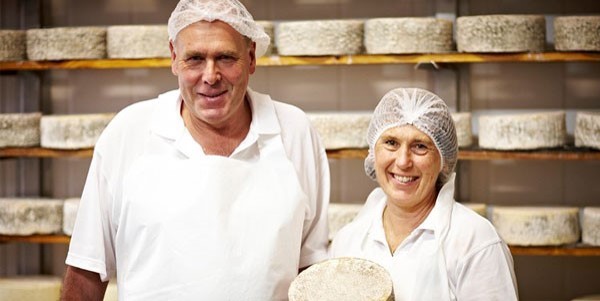Exactly How Floridia Cheese Melbourne Sets the Criterion for Local Cheese Makers
Exactly How Floridia Cheese Melbourne Sets the Criterion for Local Cheese Makers
Blog Article
Unlocking the Tricks of Artisanal Cheese Making: A Detailed DIY Overview
In the world of cooking workmanship, artisanal cheese making stands as a testimony to the fragile equilibrium between custom and development. As we begin on this trip to debunk the art of producing charming cheeses, we are faced with a tapestry of abilities and tricks waiting to be unwinded.
Picking the Right Milk
When getting started on the journey of artisanal cheese making, the choice of milk plays an important duty in identifying the quality and attributes of the final product. The kind of milk chosen impacts the taste, structure, and generally account of celebrity. Raw milk, directly from the animal, is chosen by numerous artisanal cheesemakers due to its one-of-a-kind mix of enzymes, germs, and flavor compounds. Making use of raw milk comes with threats and policies, making sterilized milk a more secure option for newbies.
In addition, the resource of the milk, whether from cows, goats, lamb, or buffalo, adds unique flavors and features to the cheese. Each kind of milk brings its very own subtleties, allowing for a wide array of cheese ranges to be crafted based on the selected milk.
Culturing and Coagulating
To launch the cheese-making process, the critical actions of culturing and coagulating need to be carefully performed to transform milk into curds and whey. Culturing involves introducing valuable microorganisms to the milk, which after that starts the fermentation procedure. These bacteria transform lactose (milk sugar) into lactic acid, creating the acidic environment needed for coagulation. The kind of society used can dramatically impact the taste, appearance, and ripening of the last cheese product.

The timing and temperature level control throughout culturing and coagulation are critical aspects that affect the final end result of the cheese. Correct execution of these actions is important to ensure the preferred appearance, taste, and uniformity of the artisanal cheese being created.
Draining Pipes and Pressing Curds
After the milk proteins have actually coagulated and the curds have actually been reduced to launch whey, the next important action in artisanal cheese making includes draining and pressing the curds to achieve the desired structure and consistency of the last cheese product. Draining pipes is the procedure of dividing the curds from the whey. This can be done by transferring the curds right into a cheesecloth-lined colander or mold and allowing the whey to drain off normally. The moment for draining pipes can vary depending on the kind of cheese being made and the desired moisture material.
When the curds have actually adequately drained pipes, the next step is pushing. Pushing helps get rid of any kind of continuing to be whey and compacts the curds to form a strong cheese wheel. Pushing can be done making use of specialized cheese presses that apply gentle and regular pressure over an amount of time. The duration and stress used throughout pressing will influence the last structure of celebrity, from soft internet and creamy to difficult and firm. Appropriate pressing and draining pipes are essential actions that significantly influence the top quality and characteristics of the artisanal cheese being produced.
Aging and Flavoring Methods
Applying careful aging and flavoring methods is crucial in enhancing the deepness and complexity of artisanal cheeses, raising their taste accounts to exquisite levels of improvement and refinement. Aging plays an important role in creating the one-of-a-kind tastes and textures that identify artisanal cheeses. During the aging process, cheeses are saved in thoroughly regulated settings where aspects such as temperature, air movement, and moisture are manipulated to motivate the development of valuable molds and germs. This controlled environment permits celebrity to develop slowly, developing complex scents and rich tastes.
Flavoring methods additionally add considerably to the last preference of artisanal cheeses. Cheesemakers may select to introduce added flavors by integrating active ingredients such as herbs, flavors, or also fruits right into the cheese throughout the manufacturing process. In addition, some cheeses are cleaned or rubbed with numerous fluids, such as brine or alcohol, to boost their structures and tastes.
Wrapping and Keeping Cheeses

Verdict
In final thought, understanding the art of artisanal cheese making Extra resources involves carefully selecting the ideal milk, complying with precise culturing and coagulating procedures, draining pipes and pressing curds successfully, and using numerous aging and flavor techniques. Remember to cover and store your cheeses effectively to make sure optimal taste and structure development.
Each kind of milk brings its own nuances, allowing for a broad variety of cheese ranges to be crafted based on the picked milk.After the milk healthy proteins have actually coagulated and the curds have actually been reduced to launch whey, the following essential action in artisanal cheese making involves draining and pressing the curds to achieve the desired texture and uniformity of the last cheese item. The majority of cheeses need to be covered in wax paper or cheese paper to allow them to breathe while protecting them from drying out. For cheeses that need to proceed aging, such as bloomy peels or cleaned skins, ensure they are stored in an awesome environment like a cheese cavern or a refrigerator set to the appropriate temperature level. By paying focus to the covering and storage of artisanal cheeses, cheese makers and fanatics can maintain the stability of these delicacies and fully appreciate their complicated flavors.
Report this page